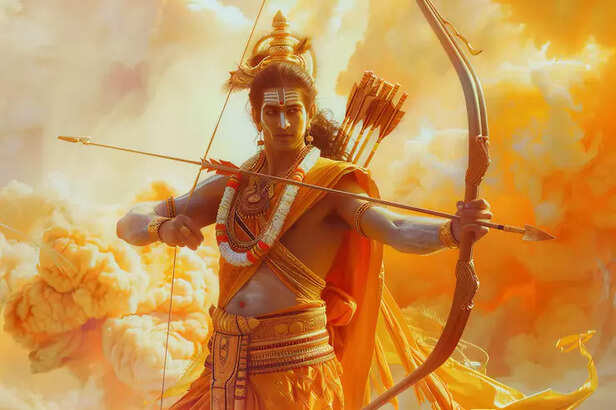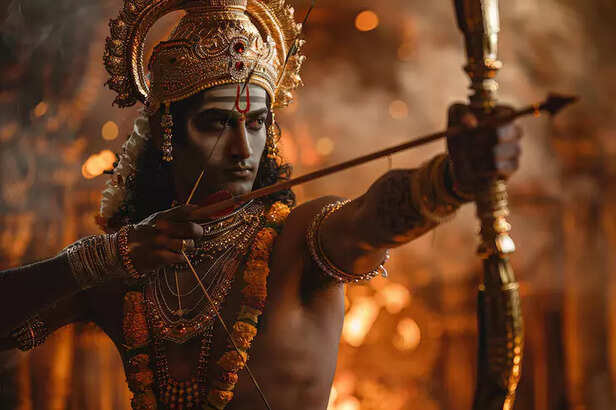Mythical or Real? 4 Mahabharata Weapons That Sound Shockingly Modern
Amritansh Nayak | May 03, 2025, 17:28 IST
mahabharat
( Image credit : Freepik )
Discover the amazing similarities between the most cutting-edge technologies of today, such as AI-guided missiles and nuclear bombs, and the ancient weapons mentioned in the Mahabharata. Could technology have been used by the gods long before it was invented? These four mythical weapons may hold the key to a lost scientific era.
One of the best epics of ancient India, the Mahabharata, describes in great detail divine weapons that are so strong they nearly seem futuristic. These fabled weapons, which range from energy beams and adaptive warfare to mind-controlled missiles, beg the intriguing question: were they merely allegories—or remnants of vanished technology? There are uncanny similarities between some of these ancient weaponry and modern technologies. The Brahmastra, Vajra, Pashupatastra, and Narayanastra are four mythical arms. Let's examine them to see if ancient societies knew much more than we do.

Historians and scholars have been captivated by the Brahmastra, one of the most terrifying weapons mentioned in the Mahabharata. This heavenly weapon, which was supposedly created by Lord Brahma himself, was so powerful that it could wipe out entire regions and render the soil unusable for millennia. Its features are interestingly similar to those of contemporary nuclear weapons. The Brahmastra is described in ancient scriptures as producing tremors, a dazzling brightness, and extreme heat that resembles nuclear explosions.
It left behind environmental devastation in addition to physical destruction. Similar to radiation poisoning and nuclear fallout, the Mahabharata describes how the land hit by the Brahmastra became desolate, with no rainfall and survivors suffering from abnormalities. The Brahmastra was also renowned for its accuracy. It might be aimed against a particular foe or site, indicating a degree of control not typical of ancient warfare. These particulars beg the question: Is the Mahabharata preserving a memory of highly developed technology that has been lost to time? Even if there isn't any concrete archaeological proof, the descriptions still lead to hypotheses that ancient societies knew far more than we usually think.
Indra, the Hindu mythological king of the gods, is said to wield the Vajra, a thunderbolt that has the power to break mountains and vanquish even the most formidable adversaries. Modern thinkers have started to wonder if the Vajra, which is typically seen as a symbol of divine might, could actually reflect some lost technology, perhaps akin to the directed energy weaponry of today. According to ancient writings, the Vajra was a weapon that could instantaneously disable opponents by emitting a great deal of light, sound, and force. These characteristics are remarkably similar to the impacts of sonic weapons or high-intensity particle beams that are now being studied in cutting-edge military science.
Some even draw comparisons to the ideas put out by Nikola Tesla, who postulated beam-based weapons and wireless energy transfer. Curiously, the Vajra is frequently shown in Tibetan and Indian art as a metallic item with prongs, resembling a small antenna or energy conductor. This has sparked conjecture that the Vajra may have been more than just a symbolic object; it could have been a remnant of a vanished civilization's highly developed technology. The similarities between the mythical Vajra and the experimental energy-based weapons of today continue to pique interest and spark discussion about the technical potential of ancient India, even if we may never fully understand the truth.

Lord Shiva bestowed the Pashupatastra, one of the most enigmatic and potent weapons in the Mahabharata, to a select group of soldiers who possessed a great deal of spiritual discipline. It was claimed to be activated and controlled solely by the user's mental attention and will, which is what made it so intriguing. It wasn't simply physically damaging. This raises the notion that the Pashupatastra is an early example of mind-controlled or biometric weapons. The Pashupatastra was not launched automatically, in contrast to other holy weapons. It implied a degree of cognitive or emotional engagement with the weapon and necessitated complete concentration and a profound meditative state.
This is comparable to newer technologies such as neurologically triggered systems and brain-computer interfaces (BCIs), which use biometric inputs or brainwaves to control gadgets. Some even theories that the Pashupatastra was "coded" to the user's aura or DNA, rendering it unusable by others—a kind of heavenly verification. The idea that ancient civilizations may have envisioned—or even accessed—forms of consciousness-driven technology that we are only now starting to investigate is reflected in this weapon, whether it be myth or metaphor.
One of the most mysterious weapons mentioned in the Mahabharata is the Narayanastra, which is credited to Lord Vishnu. Its distinctive feature was that it changed in real time, growing more powerful and unrelenting the more opposition it encountered. It could simultaneously fire hundreds of lethal bullets, sparing the unarmed and only attacking those who retaliated. Some have compared it to contemporary AI-guided missiles or autonomous drone swarms because of its sophisticated behavior. Ancient texts state that total surrender was the only way to survive the Narayanastra. It simply increased its force in response to any attempt to counter it, a tactical behavior that suggested the weapon could assess threat levels and make necessary adjustments.
This is comparable to machine learning-based weapons and adaptive targeting systems in modern warfare, which are able to determine the strength of the adversary and respond accordingly. In the past, the idea of a weapon that "thinks," chooses targets, and intensifies in response to resistance would have been unimaginable—unless they had access to a level of technology that has since been forgotten. The Narayanastra raises fascinating concerns about the breadth of old knowledge by fusing mythology and futuristic warfare, whether symbolically or literally.
The Mahabharata's weapons defy easy explanation, whether they are interpreted as myth, metaphor, or a relic of lost science. Their sophisticated qualities—precision, flexibility, and biometric activation—reflect technology that we are just now learning how to use. These ancient tales continue to inspire wonder, enquiry, and thoughtful discussion despite the lack of conclusive evidence. Perhaps the blueprints of a vanished era of scientific genius are buried deep within mythology.
Explore the latest trends and tips in Health & Fitness, Travel, Life Hacks, Fashion & Beauty, and Relationships at Times Life!

Brahmastra from mahabharata
The Oldest nuclear weapon: Brahmastra?
It left behind environmental devastation in addition to physical destruction. Similar to radiation poisoning and nuclear fallout, the Mahabharata describes how the land hit by the Brahmastra became desolate, with no rainfall and survivors suffering from abnormalities. The Brahmastra was also renowned for its accuracy. It might be aimed against a particular foe or site, indicating a degree of control not typical of ancient warfare. These particulars beg the question: Is the Mahabharata preserving a memory of highly developed technology that has been lost to time? Even if there isn't any concrete archaeological proof, the descriptions still lead to hypotheses that ancient societies knew far more than we usually think.
Was the Vajra of Indra an Actual Technological Instrument?
Some even draw comparisons to the ideas put out by Nikola Tesla, who postulated beam-based weapons and wireless energy transfer. Curiously, the Vajra is frequently shown in Tibetan and Indian art as a metallic item with prongs, resembling a small antenna or energy conductor. This has sparked conjecture that the Vajra may have been more than just a symbolic object; it could have been a remnant of a vanished civilization's highly developed technology. The similarities between the mythical Vajra and the experimental energy-based weapons of today continue to pique interest and spark discussion about the technical potential of ancient India, even if we may never fully understand the truth.

supernatural weapons
Is Pashupatastra a Mind-Controlled or Biometric Weapon?
This is comparable to newer technologies such as neurologically triggered systems and brain-computer interfaces (BCIs), which use biometric inputs or brainwaves to control gadgets. Some even theories that the Pashupatastra was "coded" to the user's aura or DNA, rendering it unusable by others—a kind of heavenly verification. The idea that ancient civilizations may have envisioned—or even accessed—forms of consciousness-driven technology that we are only now starting to investigate is reflected in this weapon, whether it be myth or metaphor.
Narayanastra: Self-Directed and Adaptable Armaments in Antiquity?
This is comparable to machine learning-based weapons and adaptive targeting systems in modern warfare, which are able to determine the strength of the adversary and respond accordingly. In the past, the idea of a weapon that "thinks," chooses targets, and intensifies in response to resistance would have been unimaginable—unless they had access to a level of technology that has since been forgotten. The Narayanastra raises fascinating concerns about the breadth of old knowledge by fusing mythology and futuristic warfare, whether symbolically or literally.
The Mahabharata's weapons defy easy explanation, whether they are interpreted as myth, metaphor, or a relic of lost science. Their sophisticated qualities—precision, flexibility, and biometric activation—reflect technology that we are just now learning how to use. These ancient tales continue to inspire wonder, enquiry, and thoughtful discussion despite the lack of conclusive evidence. Perhaps the blueprints of a vanished era of scientific genius are buried deep within mythology.
Explore the latest trends and tips in Health & Fitness, Travel, Life Hacks, Fashion & Beauty, and Relationships at Times Life!
